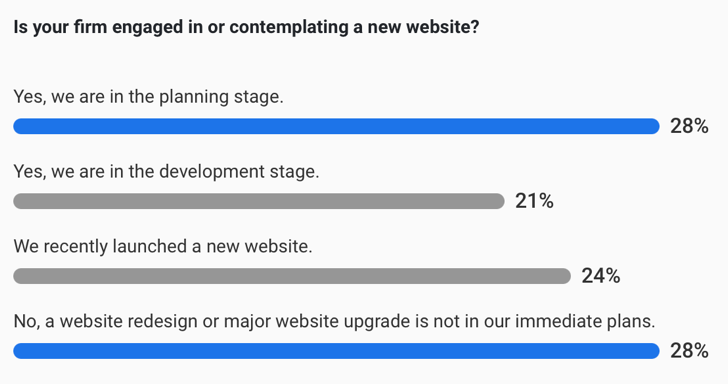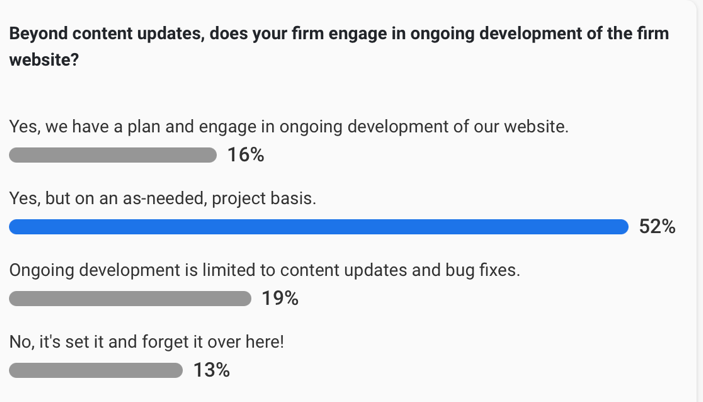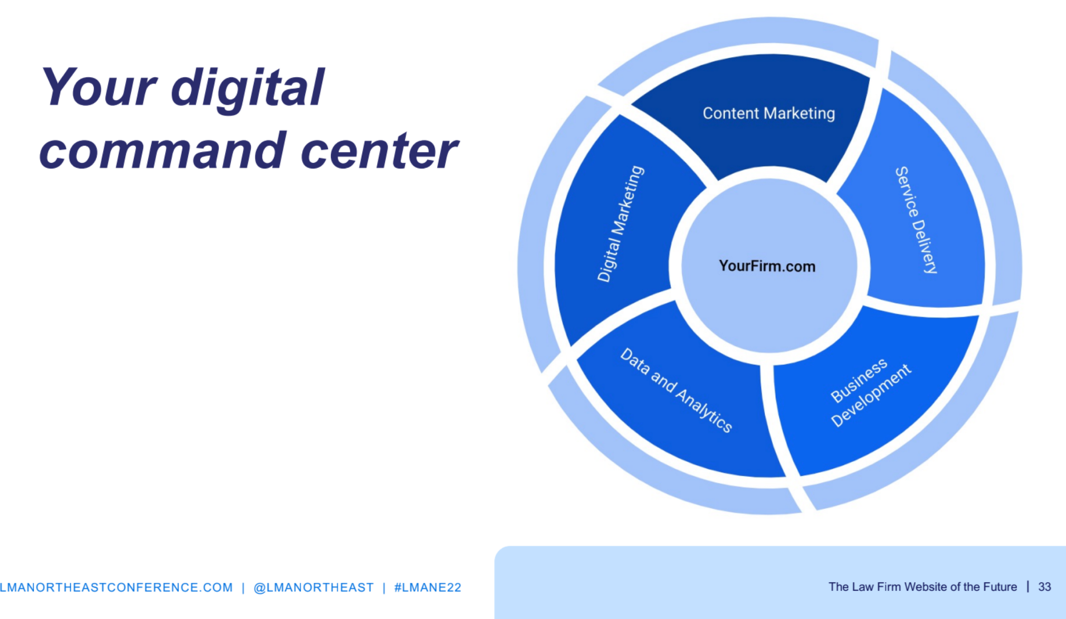How to Leverage Your Firm’s Website into a Marketing Command Center
By Lynn Tellefsen-Stehle
March 02, 2023 | 6-minute read
Communications Message and Strategy Planning Interactive and Digital Marketing Content Type Article Additional Options Content Level: Essential
Technology Management
A website is the foundation of the marketing ecosystem. Once operating as a content carrier or an online brochure, technological advances now pave the way for marketers to transform websites into a digital marketing command center — one that facilitates marketing execution, amplifies the effectiveness of marketing programs, reflects, and demonstrates brand promise, and strengthens client relations through a rich, digital experience for enhanced service delivery.
Despite achievable benefits, many law firms fail to leverage their websites into the central, unifying component of their marketing strategy. In November 2022, I was a panelist for the session, “The Law Firm Website of the Future: Harnessing Technology to Create Rich Client Experiences,” at LMA’s 2022 Northeast Conference. During the panel, I and my co-panelists polled the audience with two questions:
- Is your firm engaged in or contemplating a new website?
- Beyond content updates, does your firm engage in ongoing development of the firm website?
The survey findings were both clear and alarming — while 73% of attendees said they were contemplating building, or had recently launched a new website, beyond content updates, only 16% cited an ongoing development plan for enhancing their website.


Source: The Law Firm Website of the Future: Harnessing Technology to Create Rich Client Experiences, Nov. 4, 2022, Legal Marketing Association 2022 Northeast Conference.
To harness a website’s value and facilitate, track, measure and strengthen the digital experience, marketers need to keep pace with technological advances. This article offers substantive steps marketers can take to harness the power of their firm’s current website without deploying a new or redesigned website project.
Your Website, Your Marketing Command Center
A law firm’s website can and should become the marketer’s command center, unifying the systems, operations and teams needed to efficiently deliver continuous value to important audiences such as clients, prospects, alumni, candidates, and current employees. Why then, do so few firms choose to prioritize and invest in their current websites to create a malleable system that facilitates and scales marketing and helps their firms to drive new business?
Just as business development and marketing teams should not be siloed, the same is true for online and offline marketing programs. Your website should be regarded as the heart of your firm’s marketing operations — a highly functional mechanism that facilitates marketing implementation and enables you to measure the effectiveness of your marketing strategies and activities. Most importantly, your website should provide continuous value to both internal and external clients.
Analogous to the planets orbiting the sun, in the digital marketing ecosystem, your marketing technology systems should orbit your website.

Those who view the website as the center point for marketing realize the advantages of a powerful system that facilitates and measures marketing execution — both online and in the physical world, are confronted with a myriad of technologies, vendors, and evolving priorities. Balancing internal factors and challenges, such as other development priorities, competing for capital expenditures, limited resources and aligning innovation with organizational readiness is not for the faint of heart. Centralizing everything to your website requires planning, skill, and agility — but the payoff is well worth it.
So, what does that look like, and how can a firm get there?
Step 1: A Shift in Mindset
View your website as the center of your digital marketing ecosystem, and the place where internal aspirations become external destinations for your ideal client audiences. That is, after answering strategic questions, such as “how can we deliver a user experience that demonstrates our brand promise and satisfies today’s (and thereafter, anticipates tomorrow’s) audience expectations?”
For example, if a firm seeks to represent high-tech companies, it should deliver a website user experience that reflects and demonstrates the client’s needs and meets them at their level to provide a rich, digital user experience with continuous value.
Here are some additional strategic questions to consider:
- How well your website facilitate your marketing and business development activities?
- Is it malleable, is the code accessible?
- Does it seamlessly integrate with and/or enable full use of the features and capabilities associated with the marketing technology systems you use?
- Does it deliver the user experience that reflects your firm’s brand promise?
- Does it organize, store and feed data securely across systems, platforms, and users?
- Does it integrate with systems, data, or both, from knowledge management, your pipeline platform, IT, and finance?
Ultimately, delivering continuous value anticipates meeting each user where they are, most often with service delivery conveniences such as portals, case documentation access, payments, scheduling systems and access to other resources needed either automatically or in a way that is integrated with the service delivery process. If you are among the “set it and forget it” mindset when it comes to your website, you are not only ignoring the infinite possibilities for using it to fulfill firm growth goals, but also risk losing client/prospect audiences who are used to the digital conveniences and benefits provided by other firms.
Step 2: A Website Audit
Honestly assess how well your website reflects who you are and how you market. Start with the essence of your brand and the value, mission, purpose, and authenticity of it to your audience. Next, assess if your brand is reinforced on your website, with a positioning that sets it apart from the competition.
Some of the questions you should ask in your assessment may include:
- Does your website deliver the functionality needed to achieve your goals and satisfy clients and other desired audiences (e.g., geolocation services that serve up the most relevant information, personalization, language translation, matter portals, access to market resources and firm professionals and fast load time)?
- What opportunities do you see for using your website to improve your firm’s service delivery, communicate its brand, help fee earners manage their pipelines, promote, and conduct events and facilitate the missions of other administrative departments such as finance (e.g., collections), knowledge management (e.g., memoranda and work product), recruiting (e.g., candidates, alumni relations), IT (e.g., systems integrations), etc.?
Of course, be sure to also consider many of the marketing concerns that seem to take center stage in the website conversation, such as search engine optimization (SEO), account-based marketing (ABM) and lead generation. Be prepared to be surprised.
Step 3: A Website Road Map
To capitalize on digital marketing investments, a multi-phase website road map is pivotal. Creating a marketing command center using your website relies on a thoughtful synthesis of your firm’s unique requirements and goals, as well as emphasis and focus on the user experience. Systems integration and making informed technology decisions will help to avoid adopting closed code systems that can be unwieldly and limiting. If your team is unfamiliar with evolving web technologies, they seek, identify and retain the best vendor or platform. Your team should be supported by seasoned, outside consultants to work alongside your internal experts.
Don’t regard your website as a one and done project. It can and should be a centralized, flexible system that can continually expand, refine, measure, and report. After all, you'll seldom scale effective marketing or deliver continuous value to most if you subscribe to the “set it and forget it” website mentality.
Amplify Your Communications Knowledge at #LMA23
The 2023 LMA Annual Conference program has been strategically and thoughtfully developed to focus on the career aspirations of members, providing them tangible action steps to bring back to their respective organizations to further their growth — both from a service delivery perspective as well as a personal development point of view. Click here to learn more about #LMA23 and register.
|